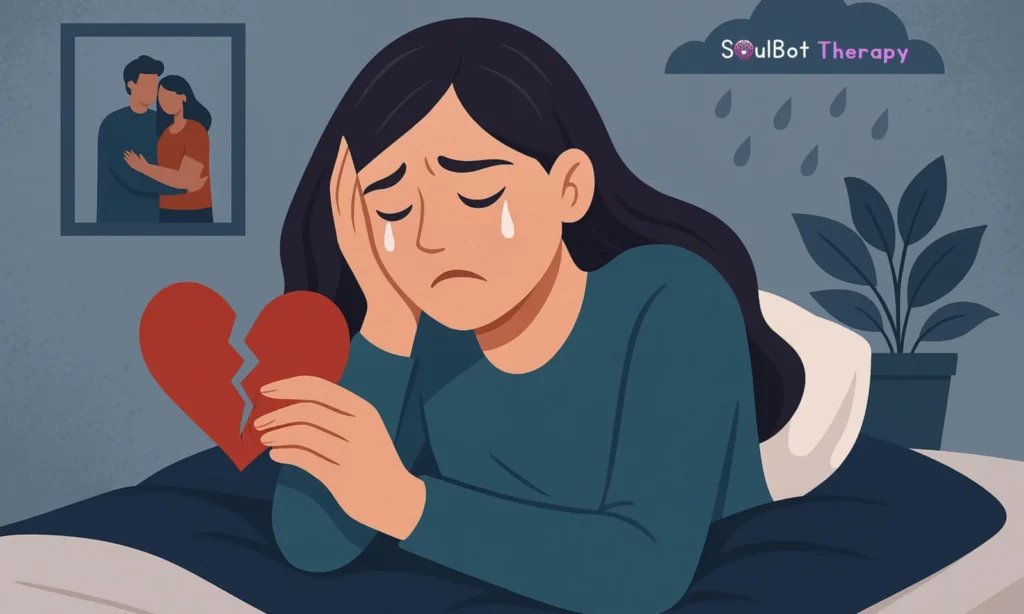Experiencing sadness after a breakup is common, but when that sadness lingers and intensifies, it may indicate something more serious: depression. Research suggests that approximately 30% of individuals experience depressive symptoms following a romantic breakup. Understanding the signs of post-breakup depression is crucial for timely intervention and recovery.
In this guide, we’ll explore the signs of breakup and depression, practical recovery tips, and actionable steps you can take today.
Curious about your emotional needs after a breakup? Take SoulBot's Love Language Test to understand how you give and receive love. Is Sadness After a Breakup Normal?
It’s natural to feel a range of emotions after a breakup, including sadness, anger, and relief. These feelings are part of the grieving process and typically subside over time. However, when these emotions persist and interfere with daily functioning, they may signal depression.
Common signs of normal breakup grief include:
- ✔ Tears or emotional episodes
- ✔ Missing shared routines or memories
- ✔ Low motivation or distraction at work or school
- ✔ Occasional irritability or anxiety
📊 SoulFact: According to NIH-focused studies, practicing adaptive coping strategies after a breakup can reduce depressive symptoms and promote emotional healing in relationships.
What is the Link Between Breakup and Depression?
A breakup can trigger situational depression when emotional pain persists beyond normal grief. Factors that increase risk include:
◉ Loss of daily companionship
◉ Disrupted self-esteem and identity
◉ Social isolation or conflict with mutual friends
◉ Major life changes, like moving out or financial adjustments
🤔Did you know? According to NIMH, stressful life events, including romantic breakups, can trigger depressive episodes in vulnerable individuals.
What are the Signs of Post-Breakup Depression?
How do you know when sadness becomes depression? Look for:
➤ Persistent hopelessness or emptiness – Indicates ongoing low mood beyond normal grief.
➤ Loss of interest in hobbies or socializing – Shows anhedonia, a core symptom of depression.
➤ Appetite or weight changes – Physical signs of mental health strain.
➤ Sleep disturbances – Insomnia or oversleeping signal emotional imbalance.
➤ Fatigue or low energy – Affects daily functioning.
➤ Excessive guilt or self-blame – Can reinforce negative self-concept.
➤ Social withdrawal – Increases isolation and worsens depression.
➤ Thoughts of self-harm or death – Requires immediate professional intervention.
👉 Action Tip: Give yourself permission to grieve. Journaling or having an honest conversation with a close friend supports understanding and managing your emotions.
Normal Sadness vs Breakup Depression
| Feature | Normal Sadness | Breakup Depression |
| Duration | 2–6 weeks | 2+ weeks with persistent symptoms |
| Mood | Fluctuating | Persistent low mood |
| Energy | Occasional fatigue | Severe fatigue and lack of motivation |
| Interest | Activities still enjoyable | Loss of interest |
| Functioning | Can manage daily tasks | Impaired functioning |
| Help Needed | Self-care and support | Professional intervention recommended |
📖 Read more about what are the signs of toxic relationship.

How to Heal Emotionally After a Breakup?
Emotional healing in relationships takes both reflection and action. Here’s a structured approach:
A. Allow Yourself to Grieve
➔ Recognize all emotions, including sadness, anger, guilt, or relief.
➔ Journaling helps process and release emotions.
B. Build a Support Network
➔ Confide in trusted friends or family.
➔ Join online support groups focused on post-breakup mental health.
C. Reconnect with Yourself
➔ Rediscover hobbies or try new ones.
➔ Set small personal goals to regain confidence.
D. Mindful Practices
➔ Daily meditation, breathing exercises, or yoga.
➔ Self-compassion exercises to reduce self-criticism.
Experiencing depression after a breakup is common, but recognizing the signs early helps prevent it from worsening.
Practical Breakup Recovery Tips You Can Start Today
Here’s a concise checklist for breakup recovery tips:
◆ Set small, achievable goals each day.
◆ Limit social media stalking of your ex.
◆ Create a personal sanctuary or space where you feel safe and at peace.
◆ Helping others through volunteering or daily gestures of kindness can enhance your emotional state and resilience.
◆ Seek accountability: check in with a friend or therapist.
Feeling weighed down by a breakup? Check out SoulBot for guided exercises that support your emotional recovery.
When Should You Seek Mental Health Support?
While mild sadness is expected, reach out to a professional if you notice:
- Signs that persist for over two weeks without showing any improvement.
- Inability to function at work, school, or in relationships.
- Thoughts of self-harm or suicide.
- Severe anxiety, irritability, or persistent hopelessness.
📊 SoulFact: According to NAMI, many experience mental health challenges yearly; SSRIs may help manage depression after a breakup, alongside therapy and support.
Final Thought
Going through a breakup and depression is part of being human, not a reflection of weakness or personal failure. Recognising signs of breakup grief, engaging in emotional healing in relationships, and using structured breakup recovery tips can restore your mental and emotional well-being.
Healing is a journey: small steps, daily routines, and self-compassion create a foundation for growth. Take it one day at a time, and don’t hesitate to seek professional support if needed.
Start your healing today with SoulBot’s guided emotional check-ins—track your moods, process feelings, and strengthen your resilience.








